Effects of Bulk Flow Pulsations on Film Cooling with Two Sister Holes
Abstract
1. Introduction
2. Geometry, Boundary Conditions
3. Numerical Methods
4. Results & Discussion
4.1. Contours of Time-Averaged η and Dimensionless Temperature
4.2. Time-Averaged Effectiveness
4.3. Instantaneous Effectiveness Contours on the Wall
4.4. Time-averaged Velocity Magnitude in the Hole
4.5. Q-Criterion Contour
5. Conclusions
Author Contributions
Funding
Institutional Review Board Statement
Informed Consent Statement
Data Availability Statement
Conflicts of Interest
Nomenclature
| D | diameter of single hole |
| L | hole length |
| M | blowing ratio = |
| Sr | Strouhal number = |
| U | flow velocity |
| Greek symbols | |
| film cooling effectiveness | |
| effectiveness at the centerline | |
| laterally-averaged effectiveness | |
| Θ | dimensionless temperature |
References
- Moran, M.; Shapiro, H.; Boettner, D.; Bailey, M. Fundamentals of Engineering Thermodynamics, 8th ed.; John Wiley & Sons: Hoboken, NJ, USA, 2014; p. 532. [Google Scholar]
- Baek, S.I.; Yavuzkurt, S. Effects of Flow Oscillations in the Mainstream on Film Cooling. Inventions 2018, 3, 73. [Google Scholar] [CrossRef]
- Baek, S.I.; Ahn, J. Large Eddy Simulation of Film Cooling with Triple Holes: Injectant Behavior and Adiabatic Film-Cooling Effectiveness. Processes 2020, 8, 1443. [Google Scholar] [CrossRef]
- Heidmann, J.; Ekkad, S. A novel anti-vortex turbine film cooling hole concept. In Proceedings of the ASME Turbo Expo 2007, GT2007-27528, Montreal, QC, Canada, 14–17 May 2007. [Google Scholar] [CrossRef]
- Javadi, K.; Taeibi-Rahni, M.; Darbandi, M.; Javadi, K. Jet-into-Crossflow Boundary-Layer Control: Innovation in Gas Turbine Blade Cooling. AIAA J. 2007, 45, 2910–2925. [Google Scholar] [CrossRef]
- Ely, M.J.; Jubran, B.A. A numerical evaluation on the effect of sister holes on film cooling effectiveness and the surrounding flow field. Heat Mass Transf. 2009, 45, 1435–1446. [Google Scholar] [CrossRef]
- Choi, D.-W.; Lee, K.-D.; Kim, K.-Y. Analysis and Optimization of Double-Jet Film-Cooling Holes. J. Thermophys. Heat Transf. 2013, 27, 246–254. [Google Scholar] [CrossRef]
- Wu, H.; Cheng, H.; Li, Y.; Rong, C.; Ding, S. Effects of side hole position and blowing ratio on sister hole film cooling performance in a flat plate. Appl. Therm. Eng. 2016, 93, 718–730. [Google Scholar] [CrossRef]
- Seo, H.; Leea, J.; Ligrani, P. The effect of injection hole length on film cooling with bulk flow pulsations. Int. J. Heat Mass Transf. 1998, 41, 3515–3528. [Google Scholar] [CrossRef]
- Kim, S.I.; Hassan, I. Unsteady Simulations of a Film Cooling Flow from an Inclined Cylindrical Jet. J. Thermophys. Heat Transf. 2010, 24, 145–156. [Google Scholar] [CrossRef]
- Gau, C.; Yih, K.A.; Chang, S. Swirling flow effect on film cooling performance downstream of a sudden expansion. J. Thermophys. Heat Transf. 1991, 5, 89–95. [Google Scholar] [CrossRef]
- Coulthard, S.M.; Volino, R.J.; Flack, K.A. Effect of Jet Pulsing on Film Cooling—Part I: Effectiveness and Flow-Field Temperature Results. J. Turbomach. 2006, 129, 232–246. [Google Scholar] [CrossRef]
- Nikitopoulos, D.E.; Acharya, S.; Oertling, J.; Muldoon, F.H. On Active Control of Film-Cooling Flows. In Proceedings of the ASME Turbo Expo, GT2006-90051, Barcelona, Spain, 8–11 May 2006. [Google Scholar] [CrossRef]
- Ekkad, S.V.; Ou, S.; Rivir, R.B. Effect of Jet Pulsation and Duty Cycle on Film Cooling from a Single Jet on a Leading Edge Model. J. Turbomach. 2006, 128, 564–571. [Google Scholar] [CrossRef]
- Gao, Z.; Narzary, D.P.; Mhetras, S.; Han, J. Upstream Vortex Effects on Turbine Blade Platform Film Cooling with Typical Purge Flow. J. Thermophys. Heat Transf. 2012, 26, 75–84. [Google Scholar] [CrossRef]
- Xiao, B.; Wang, W.; Zhang, X.; Long, G.; Fan, J.; Chen, H.; Deng, L. A novel fractal solution for permeability and Kozeny-Carman constant of fibrous porous media made up of solid particles and porous fibers. Powder Technol. 2019, 349, 92–98. [Google Scholar] [CrossRef]
- Liang, M.; Fu, C.; Xiao, B.; Luo, L.; Wang, Z. A fractal study for the effective electrolyte diffusion through charged porous media. Int. J. Heat Mass Transf. 2019, 137, 365–371. [Google Scholar] [CrossRef]
- Farhadi-Azar, R.; Ramezanizadeh, M.; Taeibi-Rahni, M.; Salimi, M. Compound Triple Jets Film Cooling Improvements via Velocity and Density Ratios: Large Eddy Simulation. J. Fluids Eng. 2011, 133, 031202. [Google Scholar] [CrossRef]
- Johnson, P.L.; Kapat, J.S. Large-Eddy Simulations of a Cylindrical Film Cooling Hole. J. Thermophys. Heat Transf. 2013, 27, 255–273. [Google Scholar] [CrossRef]
- Baldauf, S.; Scheurlen, M.; Schulz, A.; Wittig, S. Correlation of Film-Cooling Effectiveness from Thermographic Measurements at Enginelike Conditions. J. Turbomach. 2002, 124, 686–698. [Google Scholar] [CrossRef]
- Babaee, H.; Wan, X.; Acharya, S. Effect of Uncertainty in Blowing Ratio on Film Cooling Effectiveness. J. Heat Transf. 2013, 136, 031701. [Google Scholar] [CrossRef]
- Bogard, D. Airfoil Film Cooling. In The Gas Turbine Handbook; National Energy Technology Laboratory: Albany, NY, USA, 2006. [Google Scholar]
- Seo, H. Film Cooling Flow and Heat Transfer Characteristics with the Strouhal Number Variations in Pulsating Flows. Ph.D. Thesis, Seoul National University, Seoul, Korea, 1997. [Google Scholar]
- ANSYS Fluent Theory Guide. Version 19. Available online: https://www.ansys.com/products/fluids/ansys-fluent (accessed on 10 December 2020).
- Pointwise Version 18. Available online: http://www.pointwise.com/ (accessed on 10 December 2020).
- Renze, P.C.-A.; Schröder, W.; Meinke, M. Large-eddy Simulation of Film Cooling Flows with Variable Density Jets. Flow Turbul. Combust. 2007, 80, 119–132. [Google Scholar] [CrossRef]
- Iourokina, I.; Lele, S. Towards large eddy simulation of film cooling flows on a model turbine blade leading edge. In Proceedings of the 43rd AIAA Aerospace Sciences Meeting and Exhibit, No. 2005-0670, Reno, NV, USA, 10–13 January 2005. [Google Scholar]
- Acharya, S.; Leedom, D.H. Large Eddy Simulations of Discrete Hole Film Cooling with Plenum Inflow Orientation Effects. J. Heat Transf. 2012, 135, 011010. [Google Scholar] [CrossRef]
- White, F. Fluid Mechanics, 4th ed.; McGraw-Hill: New York, NY, USA, 1999. [Google Scholar]
- Jung, I.S.; Lee, J.S. Effects of Orientation Angles on Film Cooling Over a Flat Plate: Boundary Layer Temperature Distributions and Adiabatic Film Cooling Effectiveness. J. Turbomach. 1999, 122, 153–160. [Google Scholar] [CrossRef]
- Fric, T.F.; Roshko, A. Vortical structure in the wake of a transverse jet. J. Fluid Mech. 1994, 279, 1–47. [Google Scholar] [CrossRef]
- Shyam, V.; Thurman, D.; Poinsatte, P.; Ameri, A.A.; Eichele, P. Long Hole Film Cooling Dataset for CFD Development—Flow and Film Effectiveness. In Proceedings of the 50th AIAA/ASME/SAE/ASEE Joint Propulsion Conference, Cleveland, OH, USA, 28–30 July 2014; American Institute of Aeronautics and Astronautics (AIAA): Reston, VA, USA, 2014. [Google Scholar]
- Kolář, V. Vortex identification: New requirements and limitations. Int. J. Heat Fluid Flow 2007, 28, 638–652. [Google Scholar] [CrossRef]
- Schroder, A.; Willert, C. Particle Image Velocimetry: New Developments and Recent Applications; Springer: Berlin/Heidelberg, Germany, 2008; p. 382. [Google Scholar]
- Yao, Y.; Zhang, J.; Yang, Y. Numerical study on film cooling mechanism and characteristics of cylindrical holes with branched jet injections. Propuls. Power Res. 2013, 2, 30–37. [Google Scholar] [CrossRef]
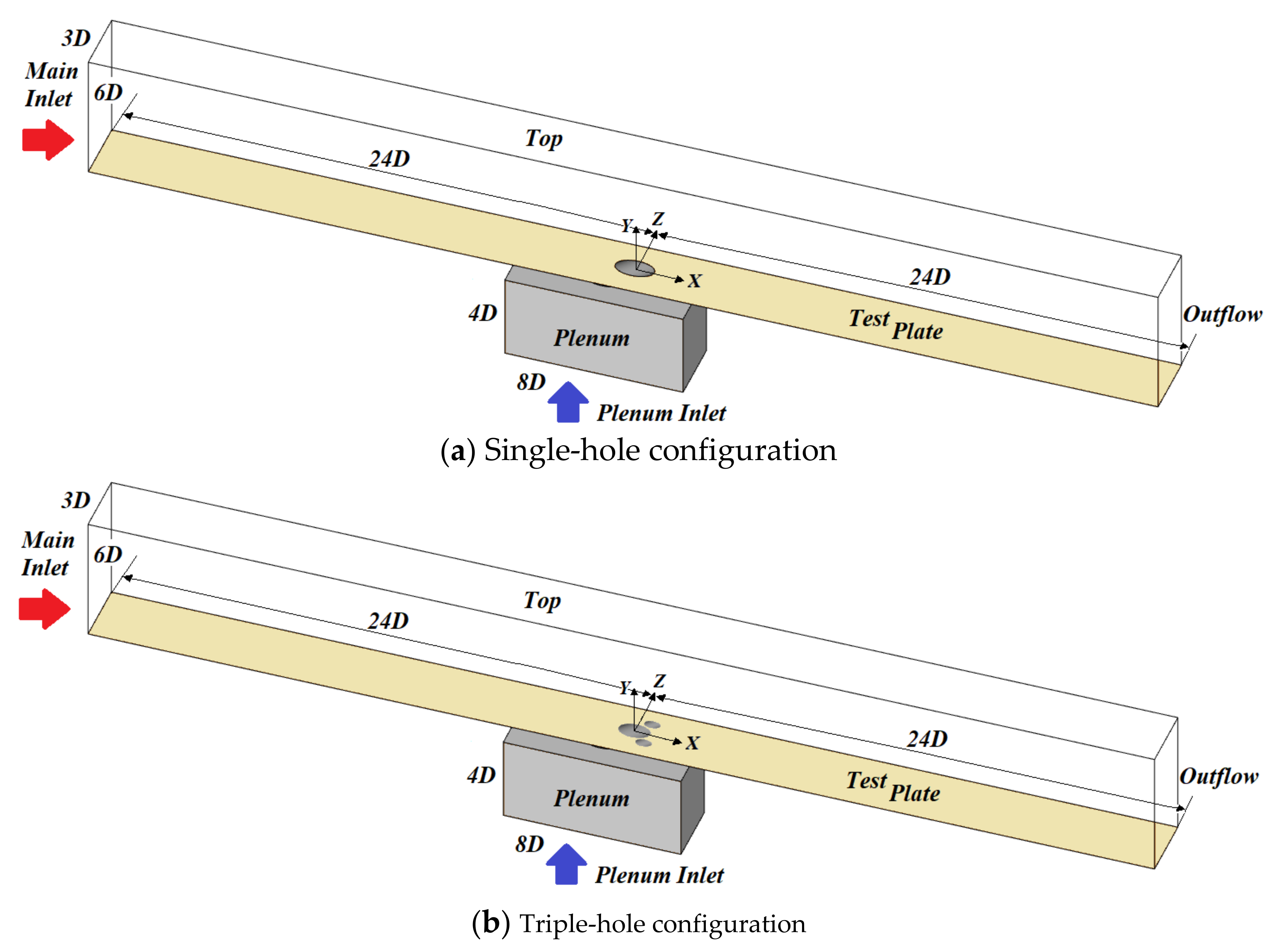


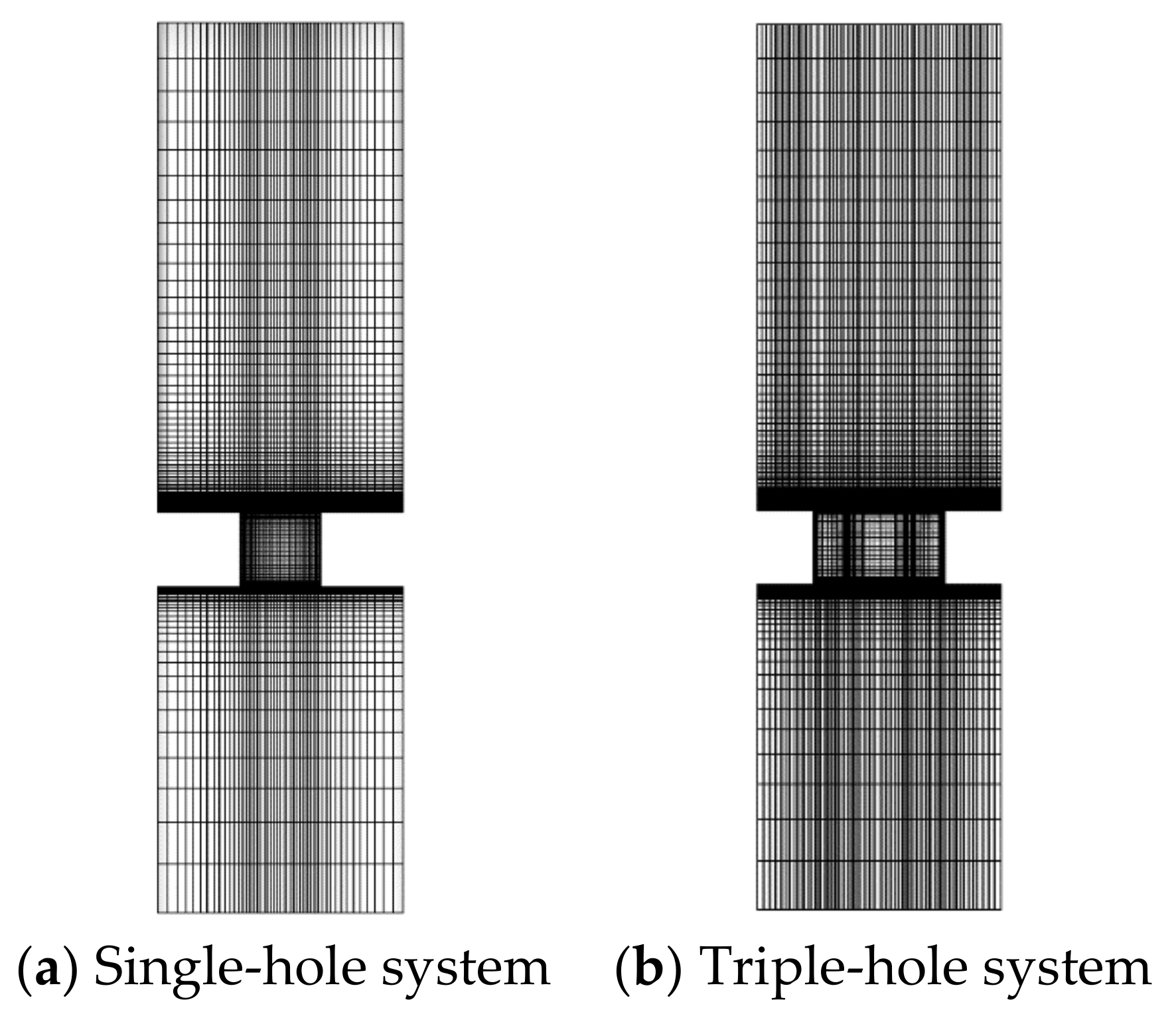
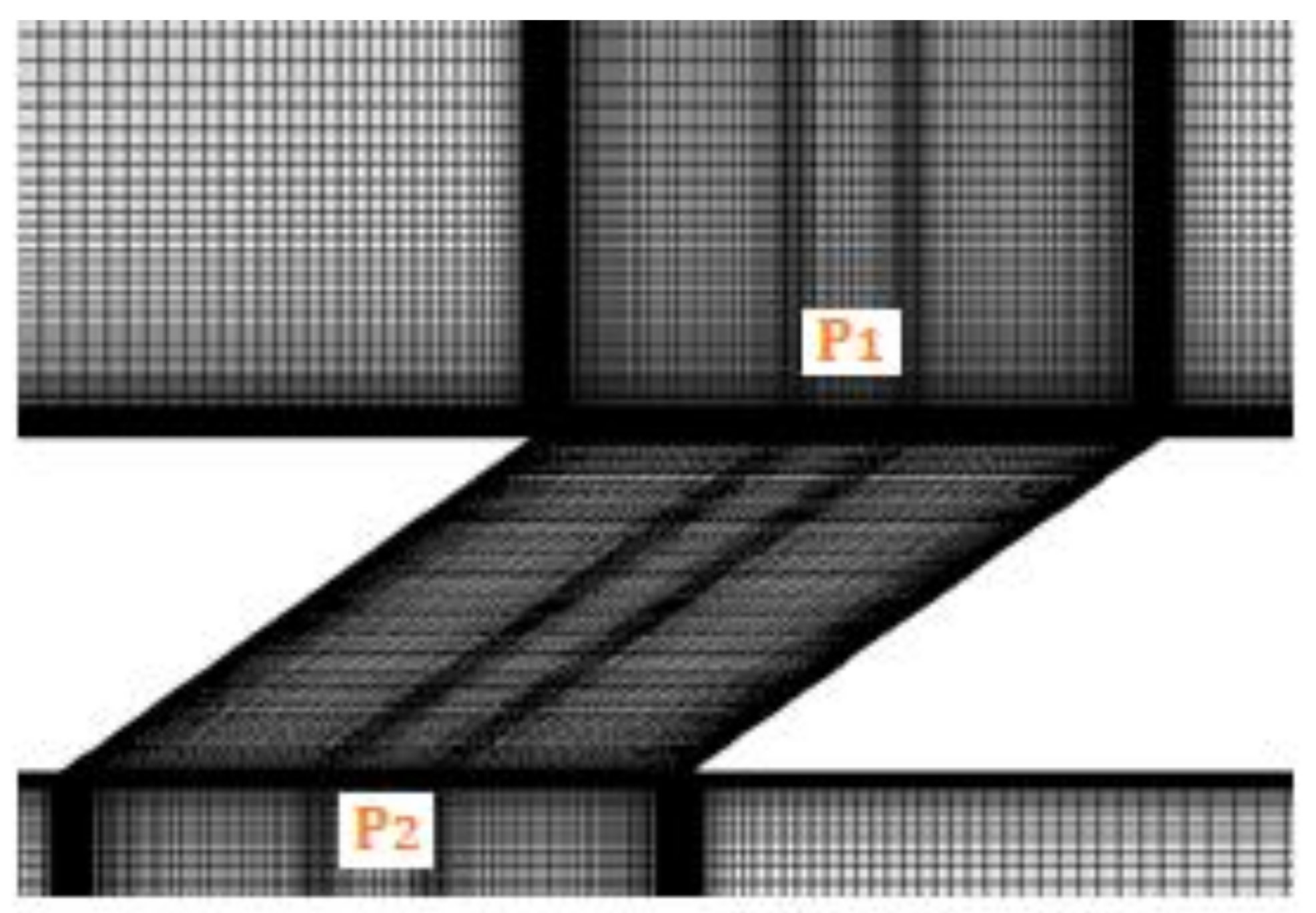
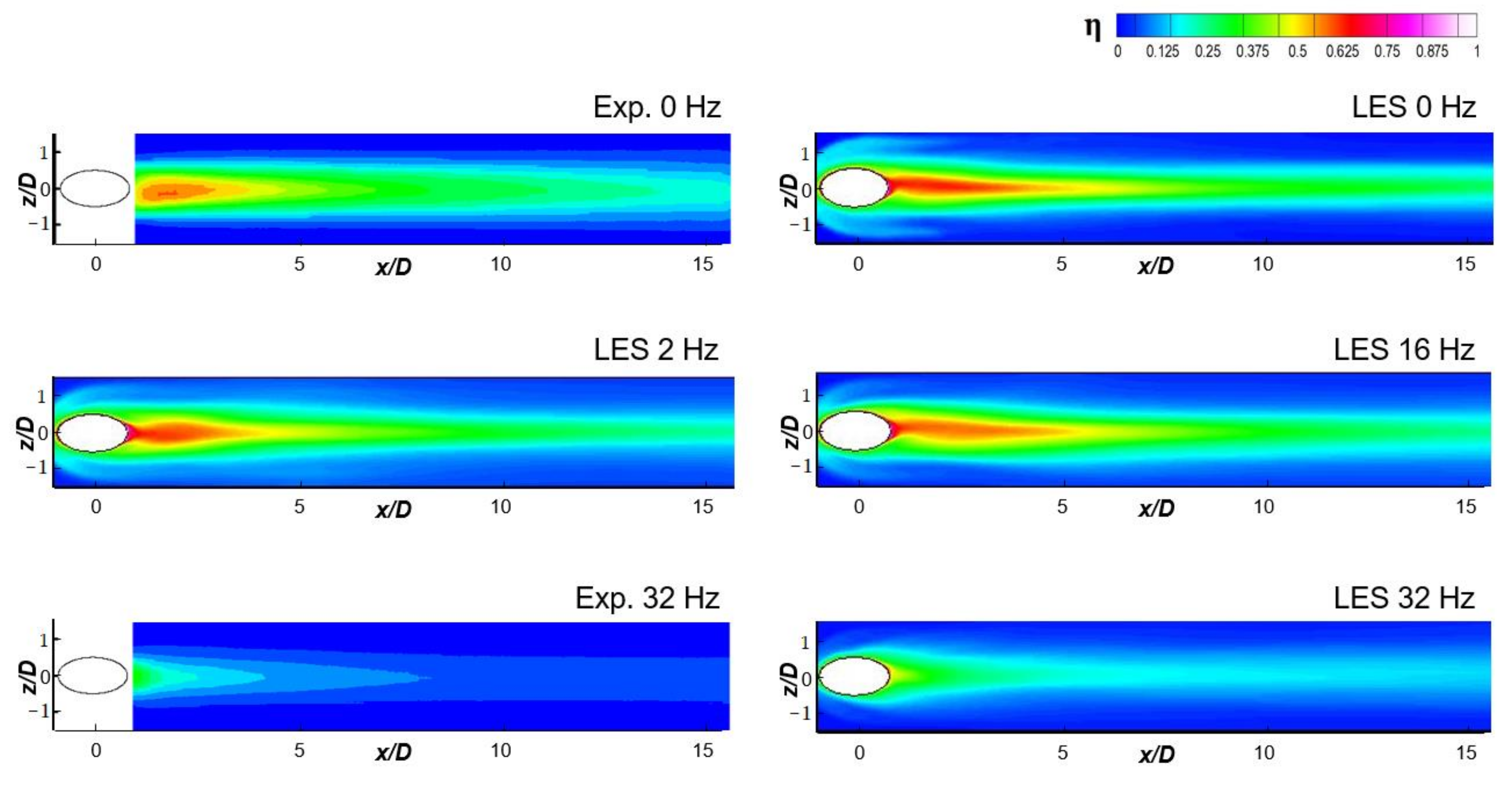
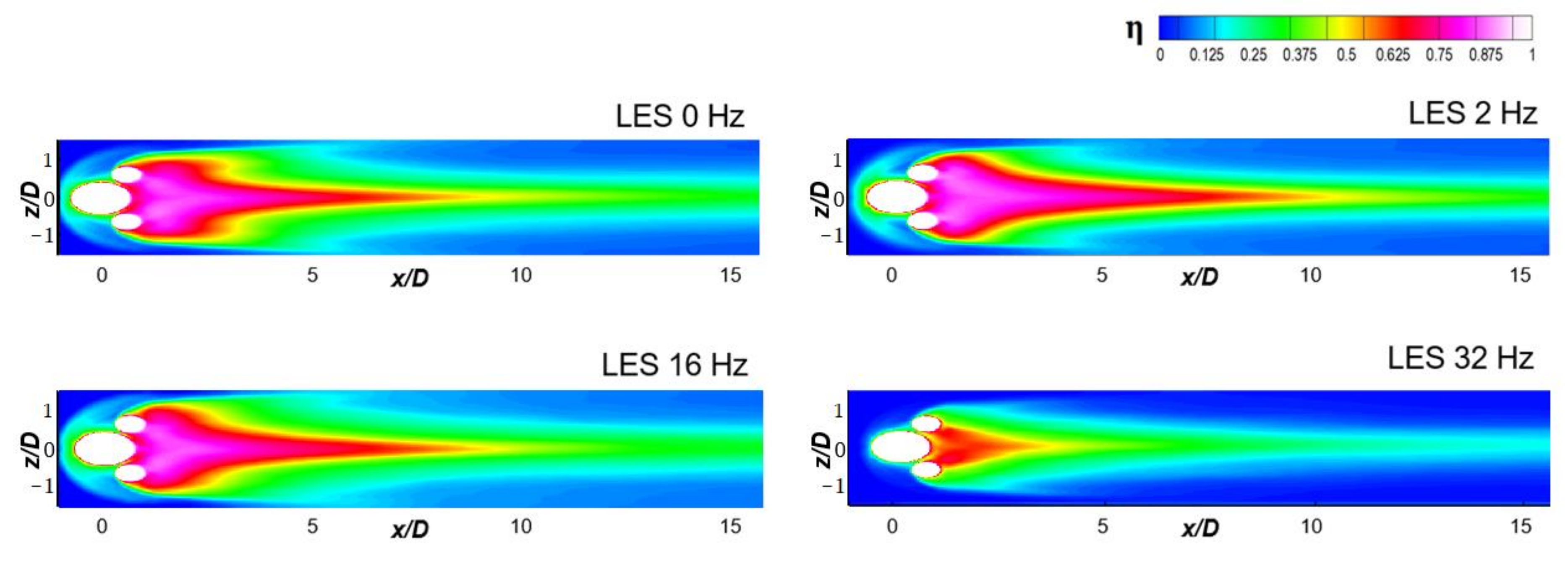
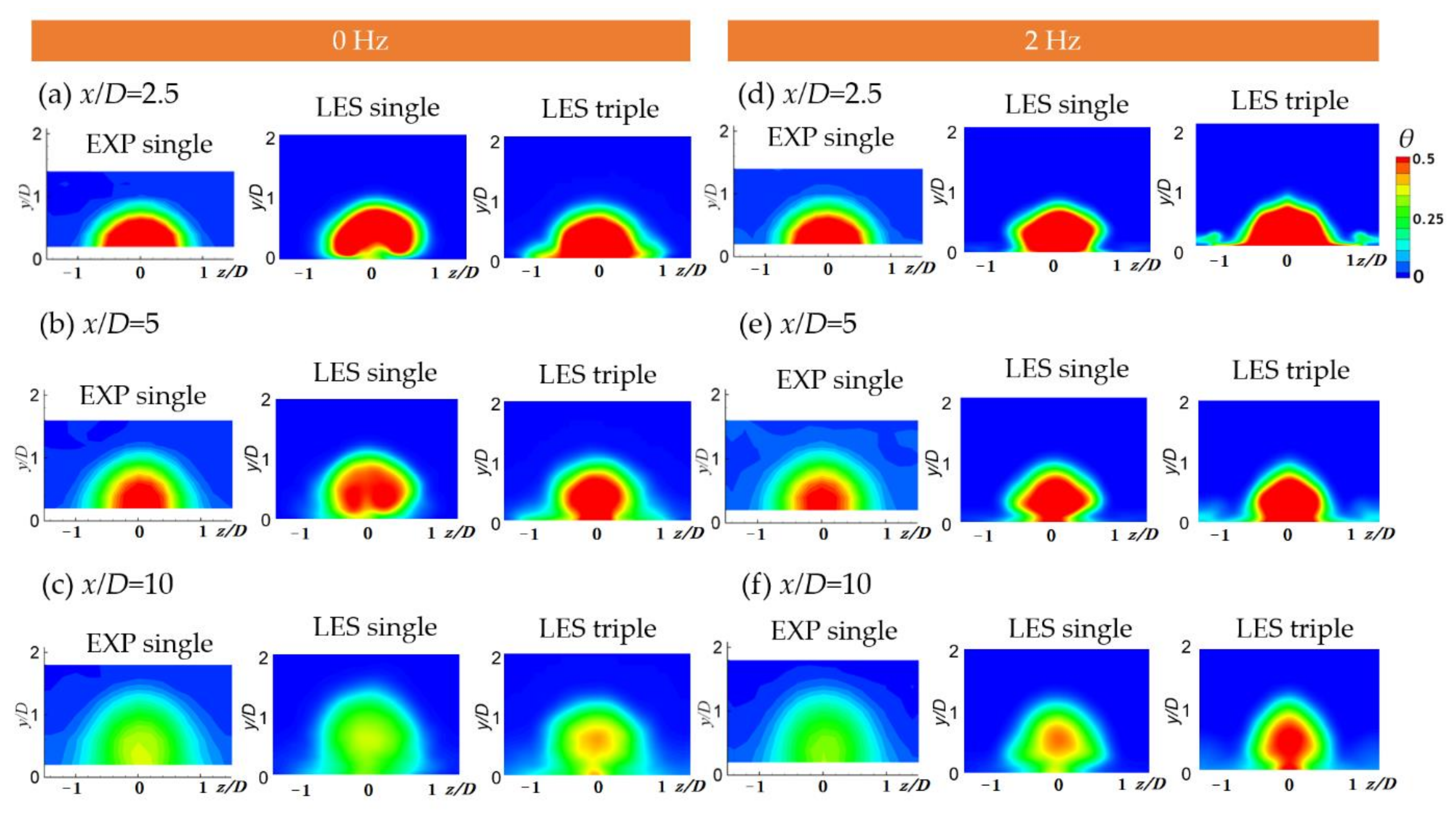
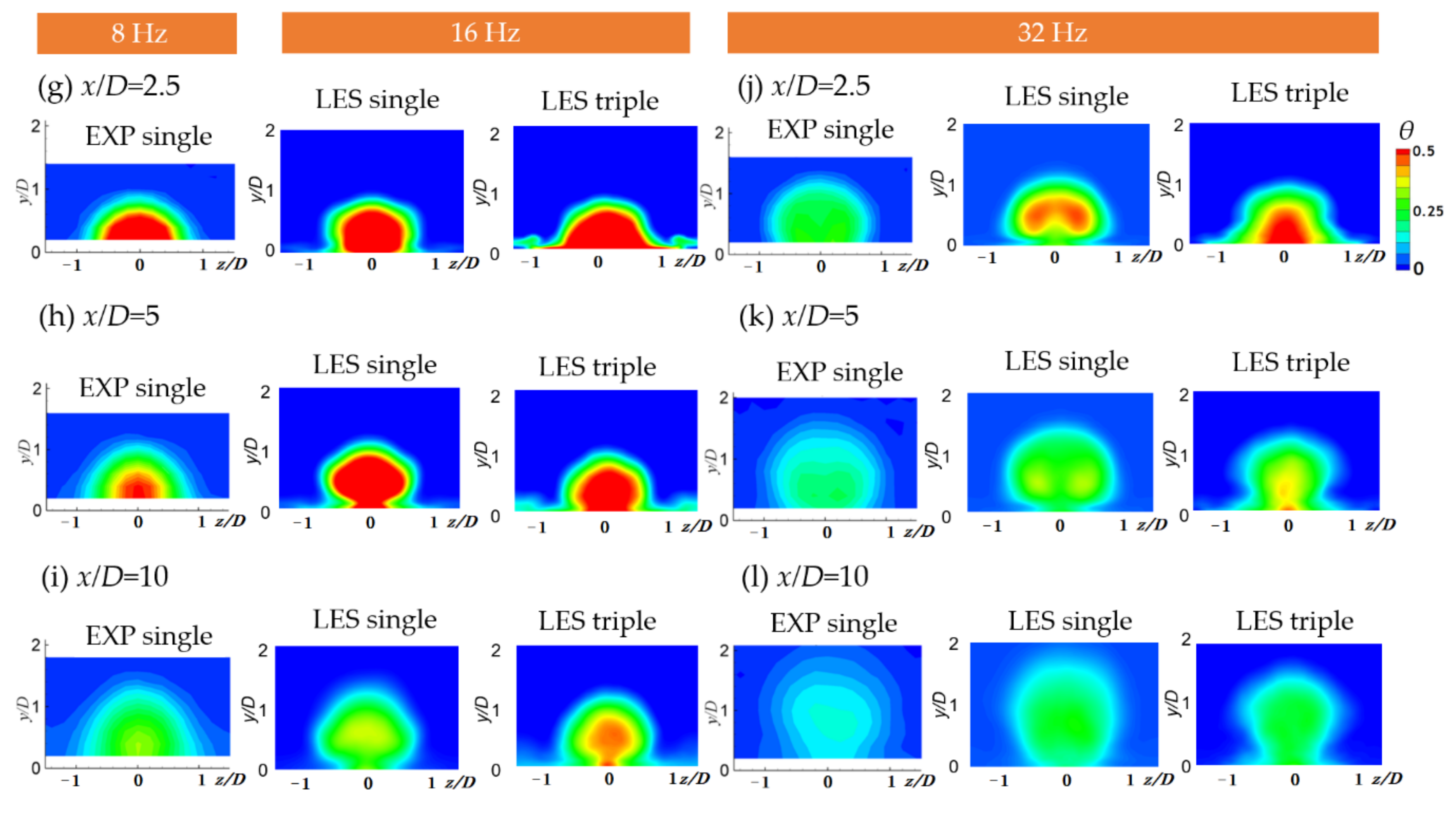
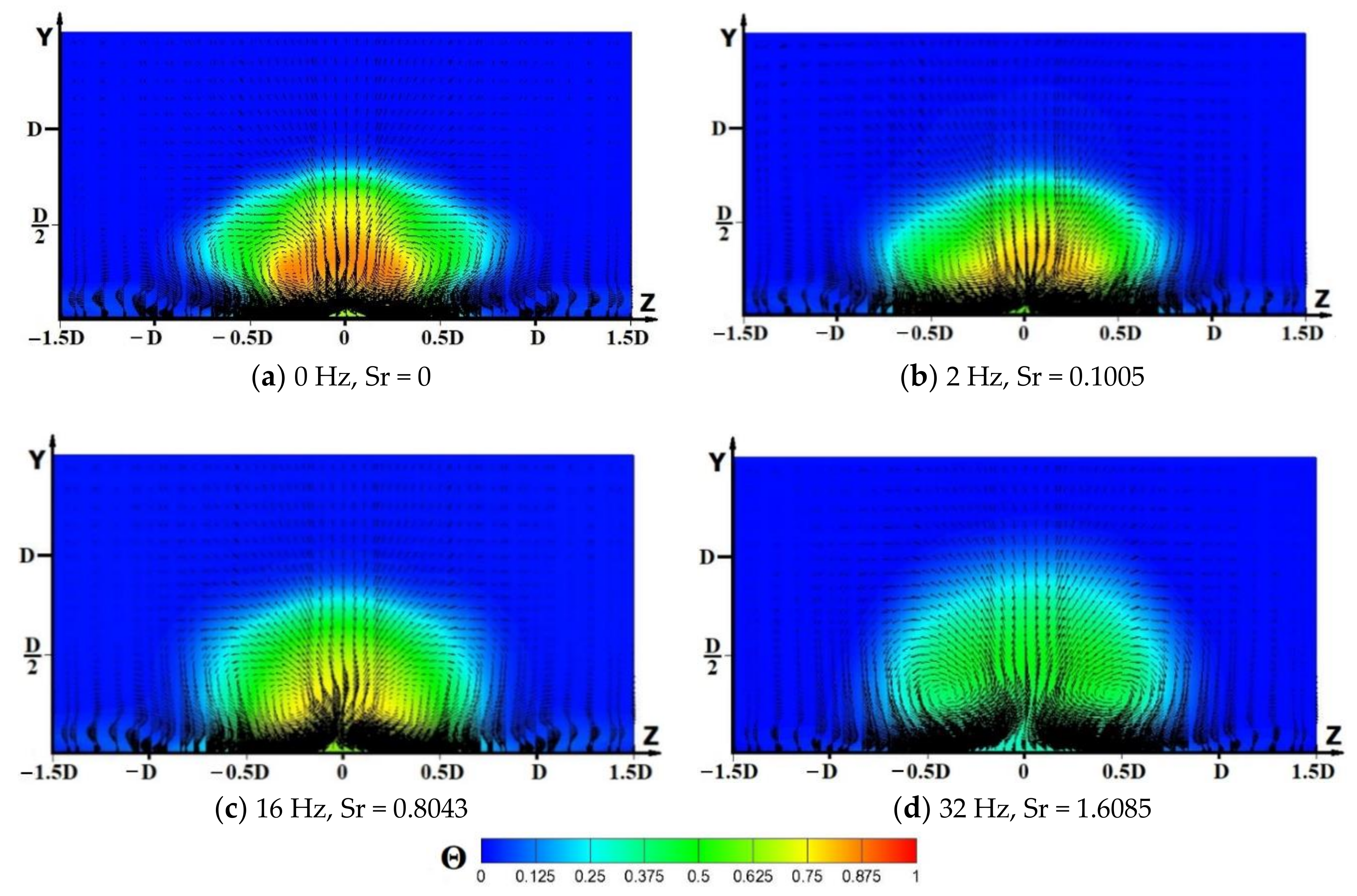
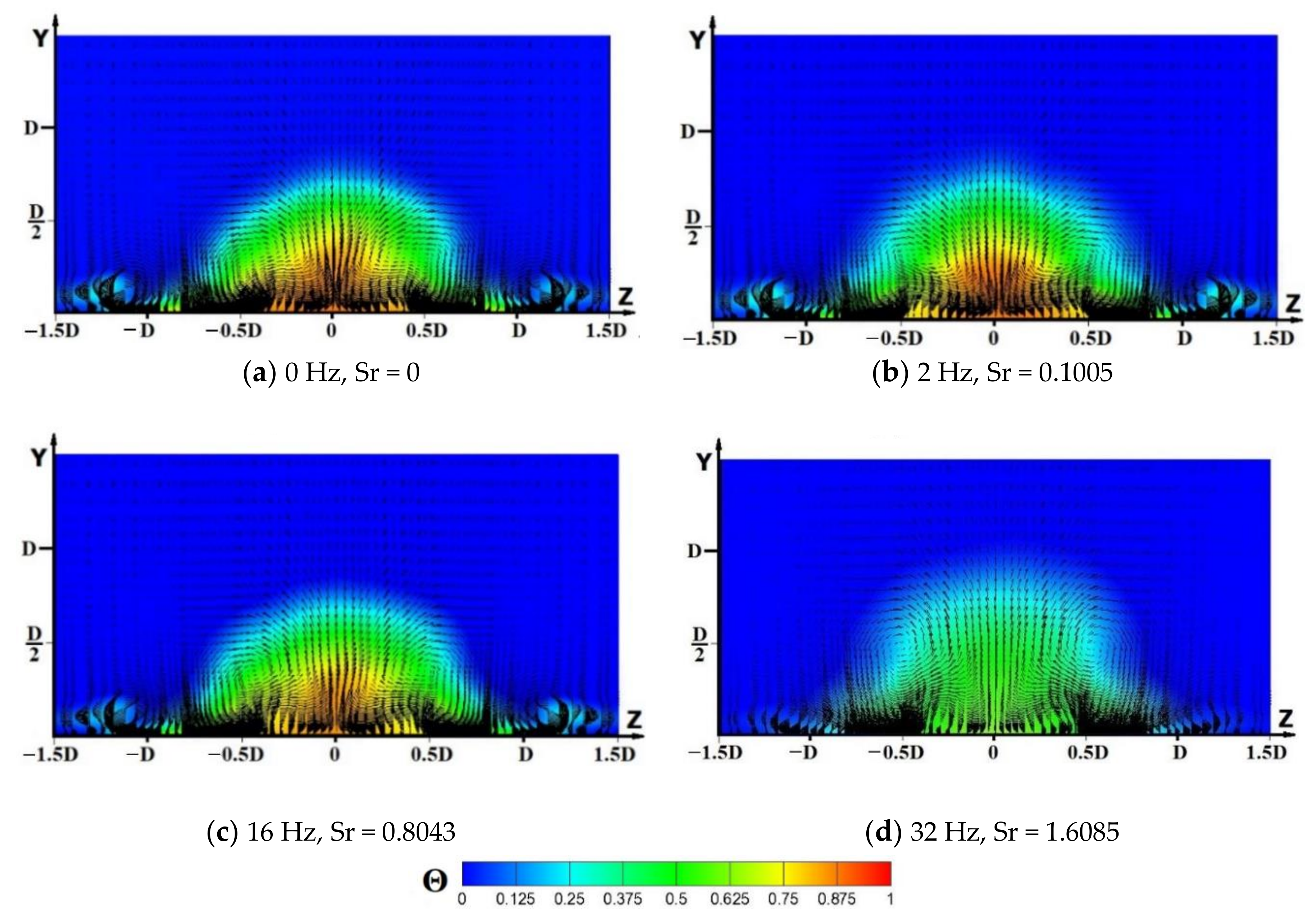


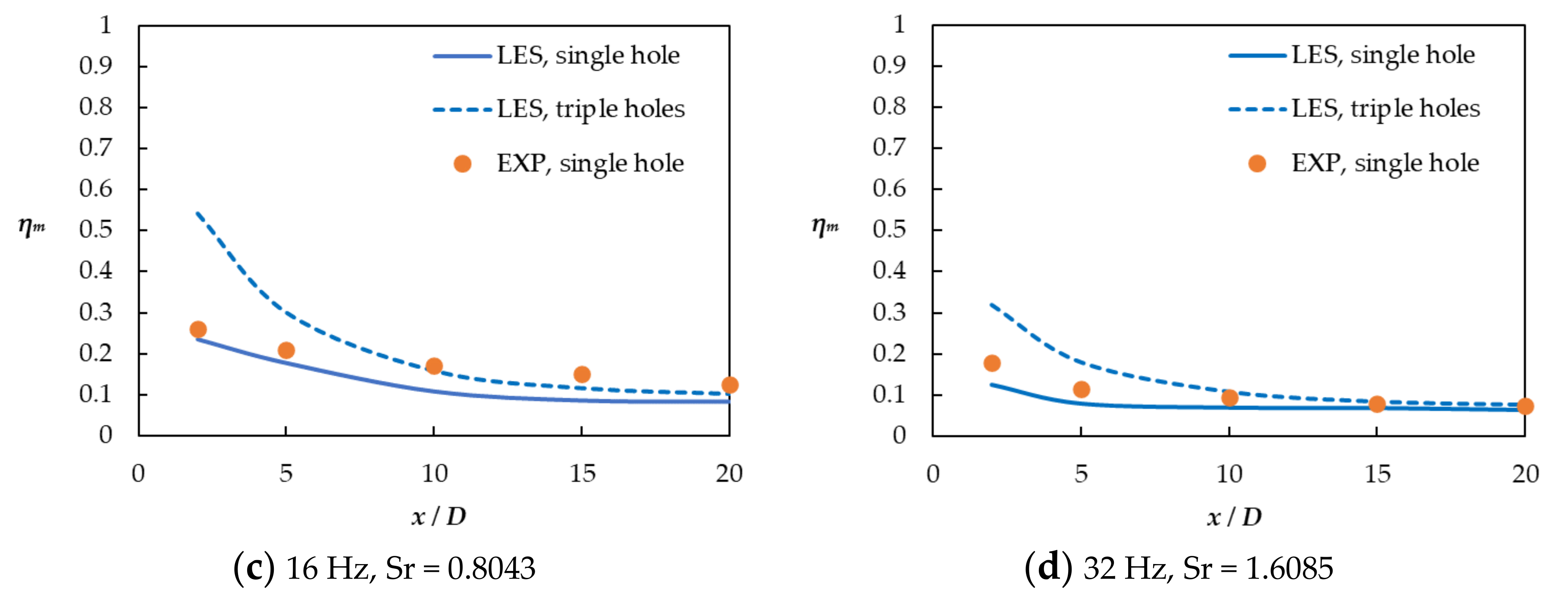
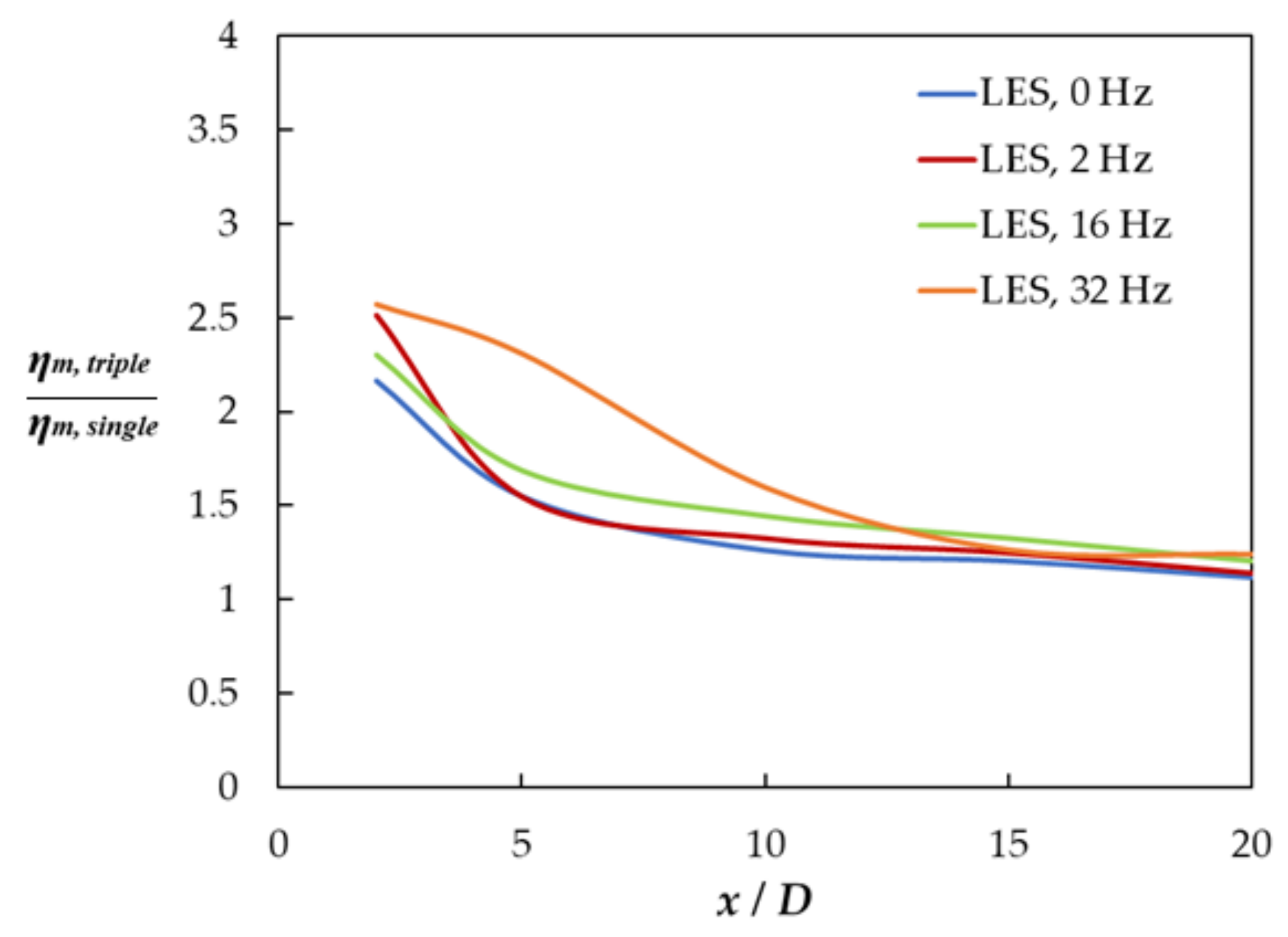
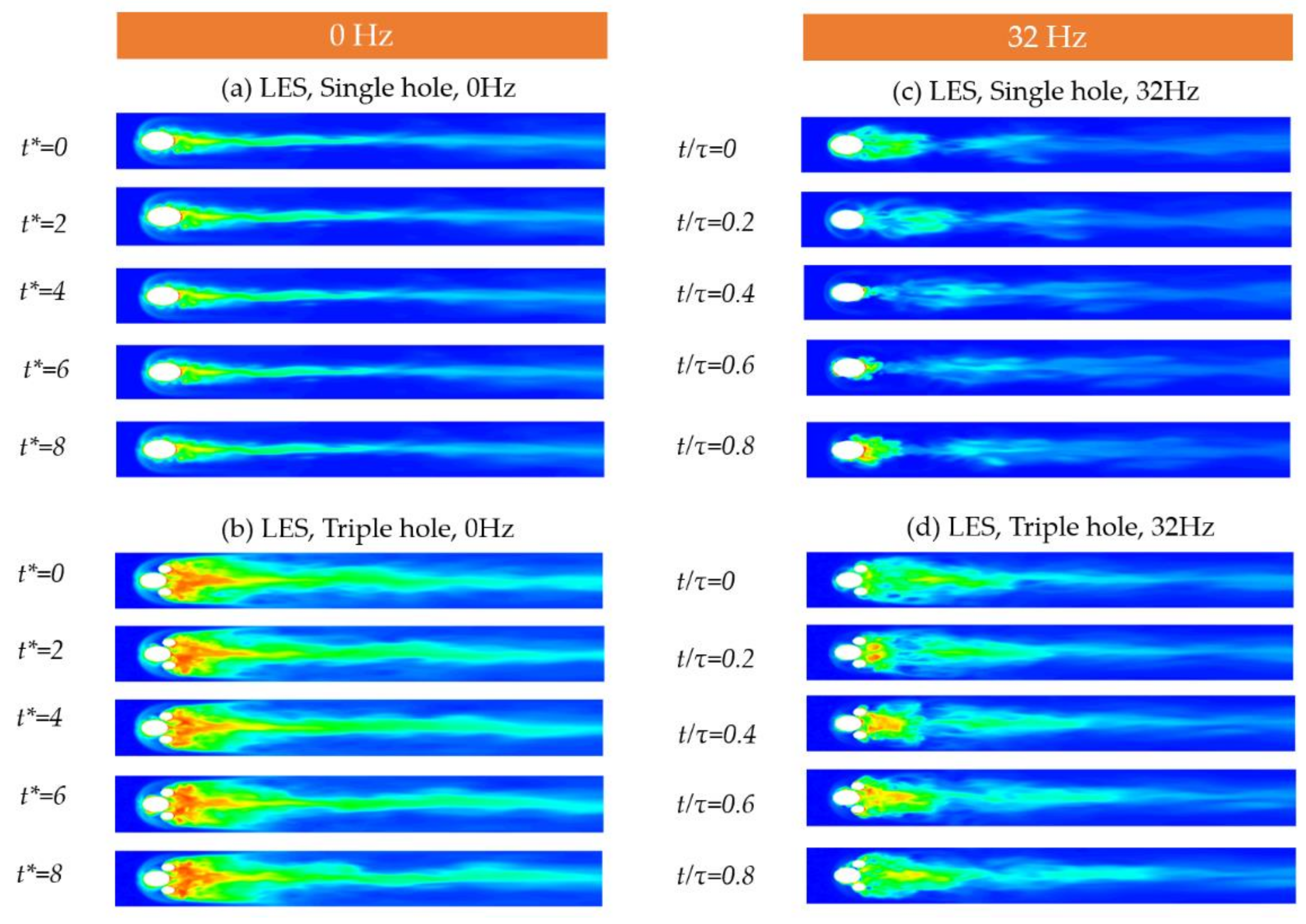

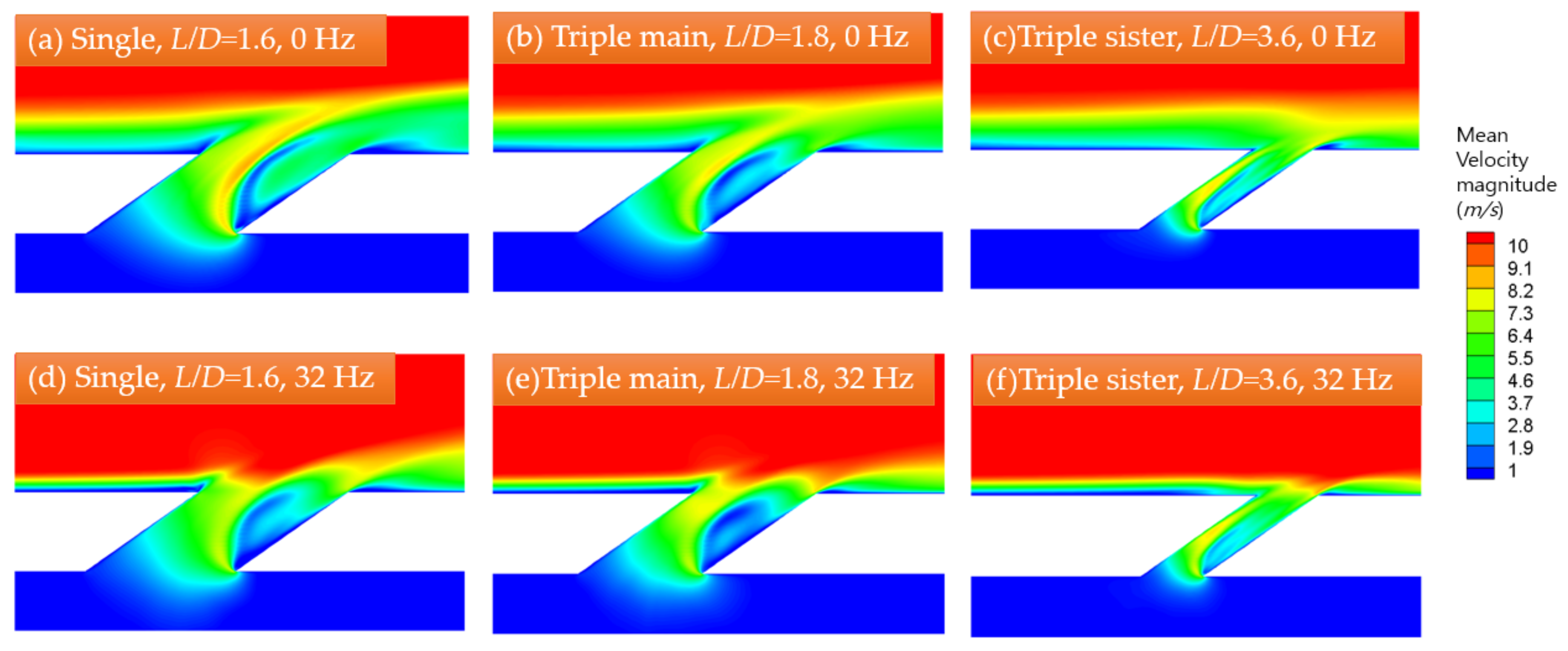
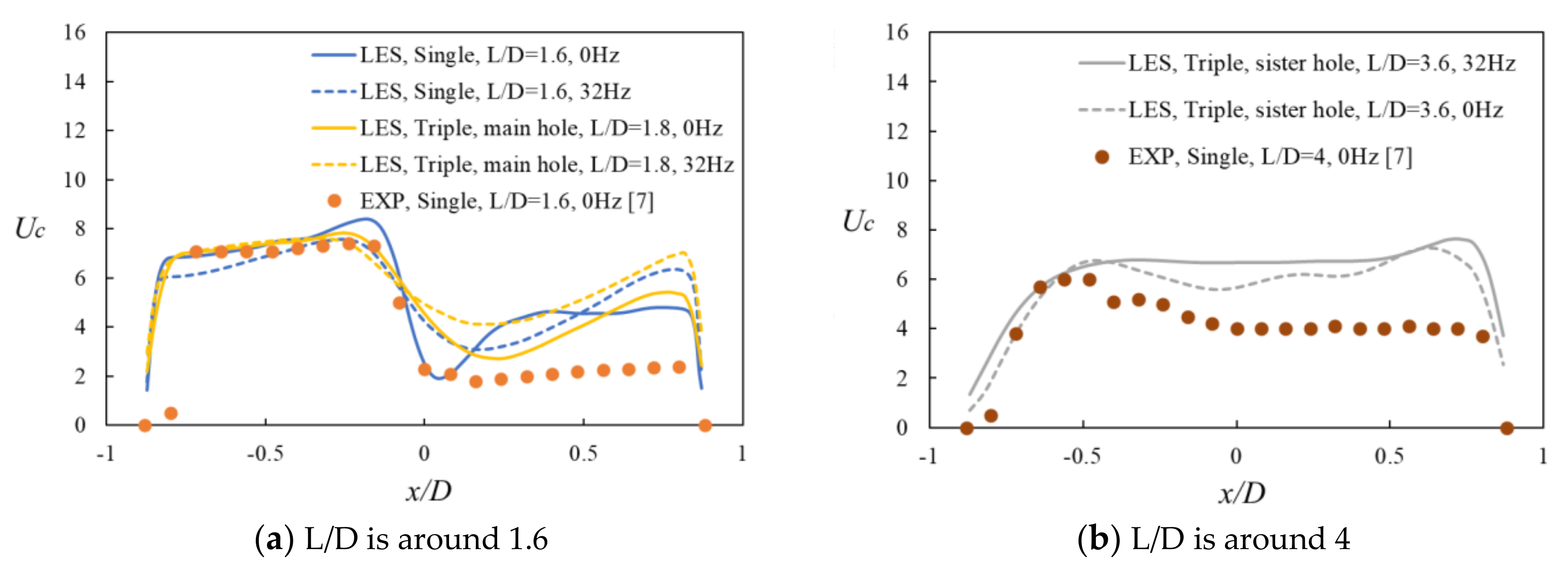
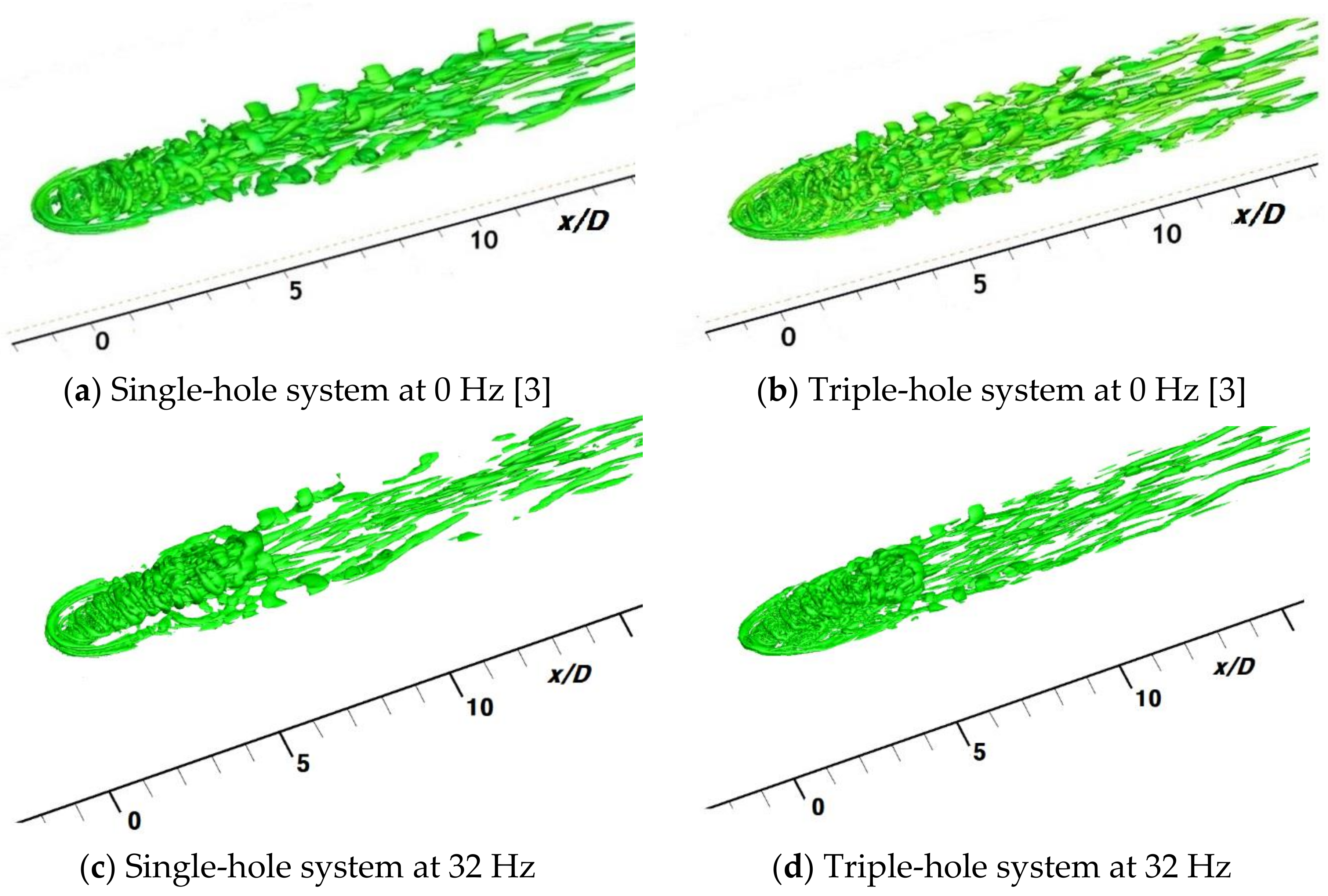
| Surface | Boundary Condition |
|---|---|
| Main inlet | Velocity inlet |
| Plenum inlet | Velocity inlet |
| Top | Symmetry |
| Test plate | Adiabatic wall |
| Outflow | Pressure outlet |
| Main sides | Periodic |
| Sides of plenum | Wall |
| Tube wall | Wall |
| Frequency (Hz) | 0 | 2 | 16 | 32 |
|---|---|---|---|---|
| Sr | 0 | 0.1005 | 0.8043 | 1.6085 |
| A | 0 | 1.82 | 0.57 | 0.44 |
| Frequency (Hz) | 0 | 2 | 16 | 32 |
|---|---|---|---|---|
| Sr | 0 | 0.1005 | 0.8043 | 1.6085 |
| B | 0 | 0.04 | 0.05 | 0.16 |
Publisher’s Note: MDPI stays neutral with regard to jurisdictional claims in published maps and institutional affiliations. |
© 2021 by the authors. Licensee MDPI, Basel, Switzerland. This article is an open access article distributed under the terms and conditions of the Creative Commons Attribution (CC BY) license (http://creativecommons.org/licenses/by/4.0/).
Share and Cite
Baek, S.I.; Ahn, J. Effects of Bulk Flow Pulsations on Film Cooling with Two Sister Holes. Appl. Sci. 2021, 11, 1537. https://doi.org/10.3390/app11041537
Baek SI, Ahn J. Effects of Bulk Flow Pulsations on Film Cooling with Two Sister Holes. Applied Sciences. 2021; 11(4):1537. https://doi.org/10.3390/app11041537
Chicago/Turabian StyleBaek, Seung Il, and Joon Ahn. 2021. "Effects of Bulk Flow Pulsations on Film Cooling with Two Sister Holes" Applied Sciences 11, no. 4: 1537. https://doi.org/10.3390/app11041537
APA StyleBaek, S. I., & Ahn, J. (2021). Effects of Bulk Flow Pulsations on Film Cooling with Two Sister Holes. Applied Sciences, 11(4), 1537. https://doi.org/10.3390/app11041537







